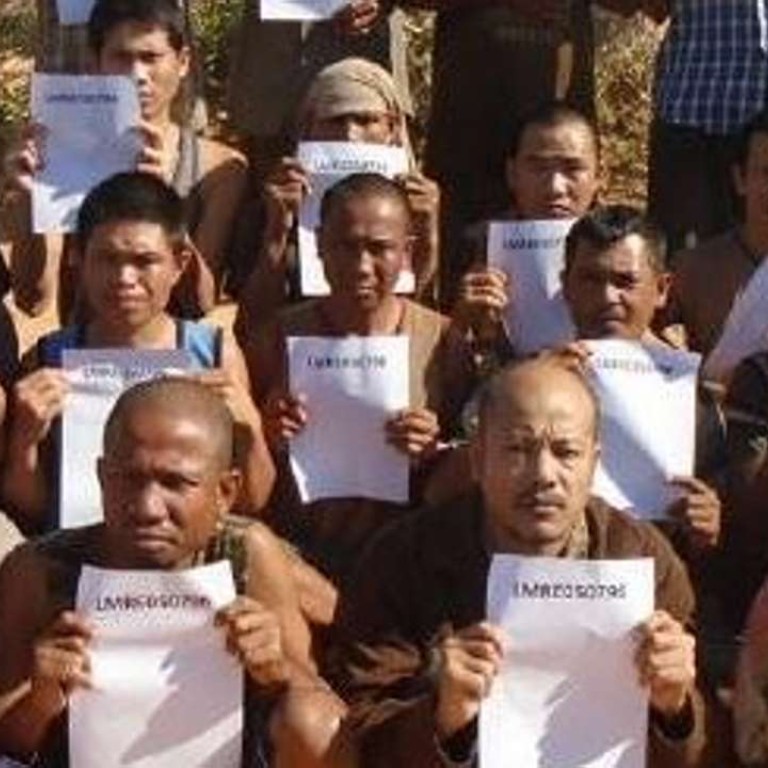
Free at last: 26 Asian sailors released after being held hostage by Somali pirates for more than four years
Fishing vessel was seized south of the Seychelles in March 2012 and the crew have been held since
For 1,672 days since their capture by a band of Somali pirates, these 26 Asian sailors languished in deplorable conditions away from their families.
Now, the sailors are heading home after a ransom was paid, and international mediators said it represents the end of captivity for the last remaining seafarers taken hostage at the height of the Somali piracy crisis.
One pirate, Bile Hussein, said the sailors were the crew of the FV Naham 3, a Taiwan-owned, Omani-flagged fishing vessel seized south of the Seychelles in March 2012. The ship later sank but the crew – from Vietnam, Taiwan, Cambodia, Indonesia, China and the Philippines – were kept hostage.
They have spent over four-and-a-half years in deplorable conditions away from their families
Hussein said US$1.5 million in ransom was paid for the sailors’ release. That claim could not be independently verified.
The 26 sailors “are currently in the safe hands of the Galmudug authorities and will be repatriated using a UN humanitarian flight shortly and then on to their home countries,” said John Steed, the coordinator of the Hostage Support Partners for the US-based organisation Oceans Beyond Piracy (OBP).
The statement included a photo, stamped August 14, showing the thin, grim crewmen standing or squatting together as proof they remained alive.
“They are reported to be in reasonable condition, considering their ordeal,” Steed said. “They are all malnourished. Four are currently receiving medical treatment by a doctor in Galkayo. They have spent over four-and-a-half years in deplorable conditions away from their families.”
He said another member of the crew died in the hijacking and two died of illness in captivity.
Steed, a retired British army colonel who has made it his objective to save “forgotten hostages”, said the mission to return the crew to their families still held one obstacle: extracting them from the city of Galkayo, where fighting was raging between forces from the rival regional states of Puntland and Galmudug.

“There is fighting in Galkayo so it is very dangerous at the moment, they are exchanging artillery tonight,” he said. “We will go in early tomorrow morning if the fighting stops and bring them back to Nairobi for medicals and a clean-up.”
Clashes in Galkayo have left at least 11 dead and over 50,000 displaced this month, the UN humanitarian agency said last week.
Steed declined to comment on the exact details but said the road to the hostages being freed was filled with peril and “heroism”.
The Naham 3 was originally tethered to another hijacked vessel, the MV Albedo, which was seized in November 2010 and released by the HSP in 2014.
When the MV Albedo began to sink “these guys jumped into the waters and rescued the drowning crew”, Steed said.
He said when the Naham 3 sank, a year after its capture, “these guys were then taken ashore where they have been ever since with pirates making increasingly irrational demands”.
Only a crew of Thai fishermen, released in February last year after nearly five years in captivity, spent longer held by Somali pirates.
Steed noted that many of the hostages still languishing in the hands of pirates are poor fishermen.
“If you don’t have insurance or you are a poor little ship no one is going to help get you out,” Steed said.

While hostage, the sailors were held in Dabagala near the town of Harardheere some 400km northeast of the capital Mogadishu which became known as Somalia’s main pirate base at the height of the crisis.
The first major commercial vessel was hijacked by Somali pirates in 2005 and the industry flourished in a country wracked by years of civil war, with few jobs and no central government.
Piracy became a major threat to international shipping and prompted interventions by the UN, EU and Nato, while commercial vessels hired private armed guards aboard their vessels.
In 2012, Somali piracy cost the global economy between US$5.7 and US$6.1 billion and at the peak in January 2011, Somali pirates held 736 hostages and 32 boats.
According to the OBP, while overall numbers are down in the Western Indian Ocean, pirates in the region in 2015 attacked at least 306 seafarers. While there has not been a successful attack on a commercial vessel since 2012, there have been several on fishing boats and there are still 10 Iranian hostages taken in 2015 and three Kenyan kidnap victims – one a very ill, paralysed woman – in the hands of the pirates, said Steed.

.png?itok=arIb17P0)